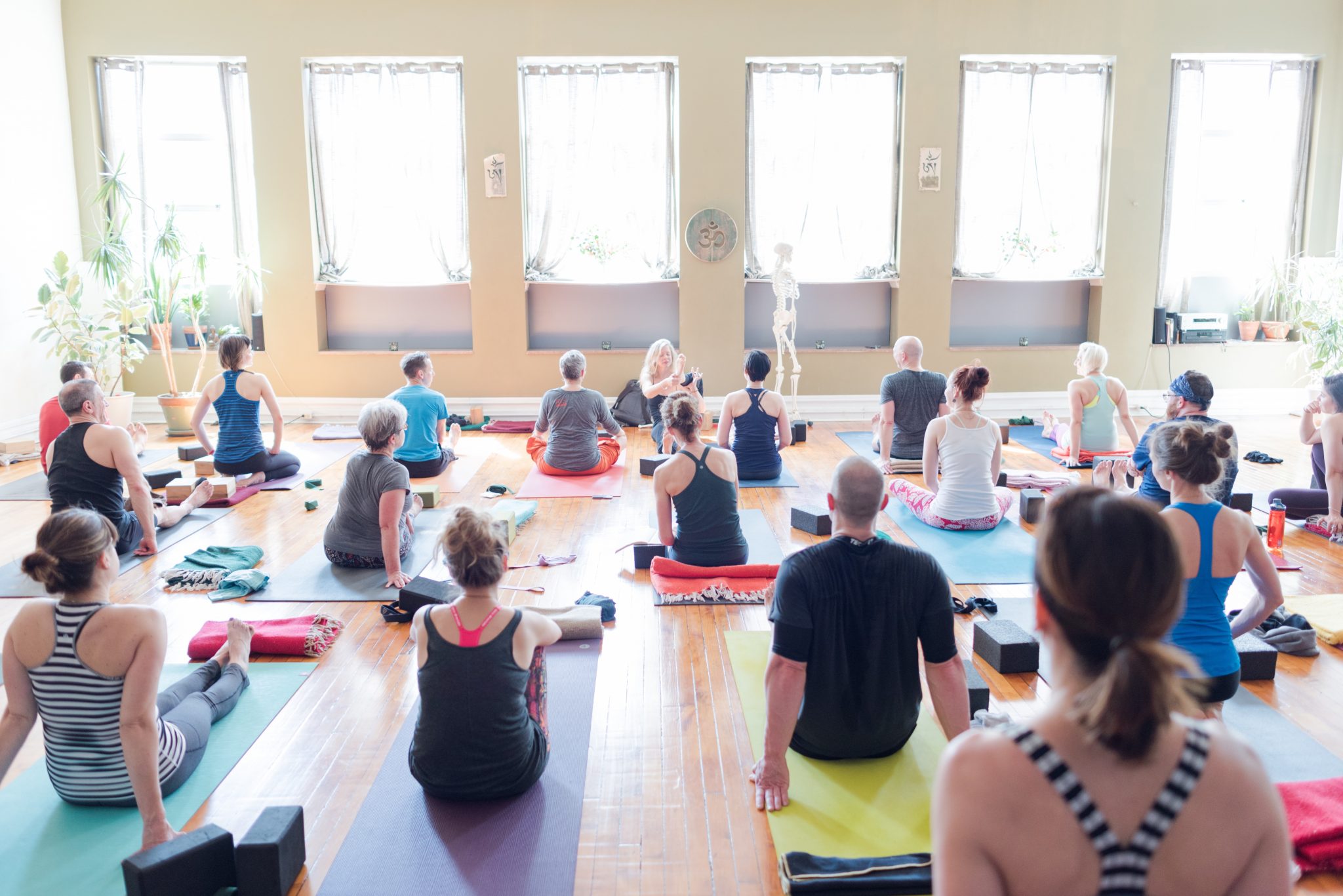When it comes to growing a yoga class, I believe that quality is more valuable than quantity. In my opinion, your success as a teacher isn’t measured by how many people come to your class, but rather in your ability to hold space. To that end, teaching yoga is not about building a following; it’s about building a community.
That said, teaching is also a profession—it’s how many of us put food on the table. Class size is a valid and omnipresent concern for many teachers. But while the art of teaching and the business of making a living often come into direct conflict with each other, you don’t have to sell out to grow your classes. Just the opposite, actually. Genuine community thrives on authenticity and passion. If you teach from your heart, you will attract the right students—your students.
Here are ten principles that have guided me through the last fourteen years in the classroom. I hope they reinvigorate your efforts and inspire you to stay true to yourself.
Focus On the Students You Do Have
If you want to grow your classes, you have to teach from a place of abundance. Don’t get trapped by the numbers. Teaching from a place of lack will only obstruct your teaching. Devote yourself to the students you do have instead of obsessing about the students you don’t have. If you walk into a classroom with five people in it, commit to teaching your best class ever. Give them the kind of personalized attention you might not be able to offer if you had forty people in the room. Build relationships and cultivate a community, one person at a time.
Give Your All
This profession demands complete, uninterrupted presence. You can’t phone it in. You can’t teach on autopilot. Know that your students can feel it when you’re not present. Here’s my advice to you: Bring 100 percent of yourself to your teaching. That means that if you only have 30 percent to give, you have to give all 100 percent of that 30 percent. Anything less is a disservice to your students. When I teach, I show up and give 100 percent. Always. My experience has taught me that my teaching isn’t me—I can be struggling personally and my teaching can still flourish. In fact, I have taught some of my best classes when I was utterly exhausted, or when I had a migraine, or when my entire life felt like it was falling apart. Learn how to clear your energy so that you can walk into the studio and do your job. Find techniques that help you get focused, whether it’s a short meditation, essential oils, or a quick handstand. What matters is that you teach with presence. You have to be all in. That kind of energy is palpable—inspiring.
Be patient.
It takes at least a year to build a class. You have to be patient. If in a few months you’re not seeing significant growth, remind yourself that it takes a year. Don’t jump ship. Continue to invest in the people who are showing up. If after a year you’re still not seeing growth, it may be time to reevaluate the class. A successful class relies on the magic trifecta: teacher, time, and style. Don’t take it personally if low numbers warrant a change. It just might not be the best fit for you. If you have to let the class go, you’ll be able to walk away knowing you gave it your all.
Be Consistent.
Don’t sub out your classes. Let me say that again. Do not sub out your classes. It doesn’t matter how much experience you have or how big your following is, if subbing becomes a chronic habit, you will kill your class. Building a community requires consistency. You have to show up, both literally and energetically. If you need to sub out your class, find a teacher whose style and values mirror your own. Contact them personally. Give your students a heads up that you’ll be away and encourage them to take your sub’s class. Another tip: Invite your sub to take your class in advance. (This used to be common practice back in the day; if we were confirmed to sub a class, it was expected that we were to attend the teacher’s class the week before so that we could introduce ourselves to their students and experience the class for ourselves.) Have the teacher demo a posture. Introduce the teacher to your students. Have a laugh all together! Create an opportunity for connection. This way, the sub is no longer a stranger, but a member of the community. Above all, remember that no matter what you do, your numbers will drop when you sub out your class.
Cultivate Genuine Relationships
Get to know your students—their names, their practices, their hearts. Show up early and greet them at the front desk as they’re checking in, or welcome them into the classroom as they arrive. Stay late and answer questions. I often end my classes by saying, “Thank you so much for sharing your practice with me. My name is Chrissy. I’d love to meet you. Feel free to introduce yourself after class.” I want to get to know my students because, after all, it’s their class. By cultivating genuine relationships with my students, I learn how I can best serve them as a teacher.
Care for Your Classroom
Here’s a little secret: When I show up to teach, I pretend that the studio is my home. I try to come early and set up the classroom—I clean up trash, fold blankets, make sure I have enough props, and set the lights and the temperature so that when students arrive, the studio feels welcoming. When you tend to the space, you elevate the vibration of the studio and set the tone for your class.
Be Inclusive
Treat each student as if they were a guest in your home. Remember that everyone is coming to yoga for their own personal reasons and that there’s more than one way to approach a practice. While honoring your values and principles as a teacher will help create a safe space, dogma and rigidity can ostracize new students. Be kind—you have no idea what your students are struggling with or what battles they’re fighting. Create a space where everyone feels welcome.
Teaching Beyond the Classroom
Expand upon the themes from your classes outside of the classroom. Elaborate on your teaching by writing a blog post or a newsletter, or by sharing your ideas on social media. Keep the conversation going and nourish your community beyond the walls of the studio.
Live Your Life
It’s so important to have a life outside of teaching. Real life experiences offer you a few necessary things: space to just be, time to explore, and (ironically) context for the things you talk about in class. Study, yes. Talk about yoga with your yoga community, yes. Pursue continuing eduction (see below), please! But then go bowling.
Refine Your Craft
Be a student. I can’t emphasize this enough; it’s the most important tip I can share with you. You must continue your studies. Invest in workshops, trainings, and retreats. Burn out is not about exhaustion (although exhaustion is a symptom of burn out); it’s about giving from an empty cup. Your students can feel it when you’re not practicing. You have to keep learning. If you’re excited about what you’re teaching, your students will be excited, too. That kind of energy is electric and contagious.
Bonus Tip: Don’t apologize for who you are or what you teach.
In closing, be yourself and teach what lights you up inside. Don’t try to sell your teaching or yourself. You can’t be everyone’s teacher. There will always be people out there who don’t get you and/or don’t like you and what you have to say. That’s ok. The harder you try to convince someone to receive what you’re offering, the less likely they’ll be to pick up what you’re putting down. Relax. Tether yourself in your practice. Allow students to come and go. Don’t hold on. Don’t coerce. Teach what you know and love with grace and humility, and know that that’s enough.
Photo credit: Levana Melamed






Such great reminders! Thank you for your insight. I’m only starting my third year in teaching and starting to build my own community of students. All of these points ring true and are such great reminders. I’ve come to teaching late in life (after 50) but, I’m enjoying the journey and sharing what I love!
Hi Leanne! That’s wonderful! I totally agree—what an honor it is to teach! I’m so happy to hear that these tips ring true for you. Thank you so much for your comment.
Thank you so much for the great advice, Chrissy!! I’m bookmarking your article! 🙂
Hi Amy! I’m so glad you found it helpful!
Thank you so much for sharing! I can always feel your energy radiate out when you teach because you actually love teaching. I love the last bonus tip the most ❤❤❤
Aww, Liz, thank you! Sending you love.
This is fantastic advice! In an industry where it’s easy to feel like you have to be loud and flashy to be successful it’s important to hear that showing up, putting in the work and connecting to your students is how to cultivate sustainable success and community. Lessons that I will continue to draw from and share.
Thanks so much for your comment, Nicole! You’re so right, there is a lot of pressure out there to deliver on an expectation. Always be yourself. You’re an incredible teacher.
[…] Growing Your Classes […]
I love your blogs chrissy. Im inspired to be a teacher one day. Now im practising alot and just started two years ago but yoga has heal me a little bit as i have minor scoliosis. Could you give me few tips on to practice yoga at home for scoliosis. Thank you for sharing. Namaste x
Thank you so much Layla! Aspiring to be a teacher is a worthy endeavor—it’s a profound profession. I’m so glad that yoga has given you tools to help you with your scoliosis; that’s amazing. It’s challenging for me to give you advise without seeing your body in person. I would, however, recommend you check out Allison West’s offerings. Her studio in NYC, Yoga Union, is devoted to back care and scoliosis. She also shares some great information online via her website and on social media. http://www.yogaunion.com
So helpful, Chrissy. Thank you :).